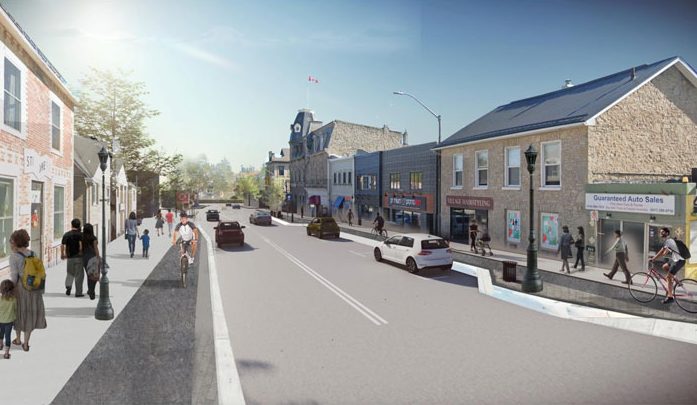FERGUS – St. David Street North in Fergus, which is also Highway 6, will see a controlled pedestrian crossing installed at St. George Street as part of the street reconstruction that begins next spring.
At its Oct. 16 committee of the whole meeting, Centre Wellington council voted in favour of a staff recommendation to endorse the crosswalk across the busy highway.
The crosswalk was part of the application by the township to the Ministry of Transportation for a Connecting Links grant, which was successful.
The township will receive $2,849,176 from the province. The total cost of the project, which includes replacing water mains, sanitary sewers and storm sewers, is $8.3 million, which is budgeted over two years.
The ministry requires a resolution from council endorsing the pedestrian crossing.
Manager of engineering Adam Gilmore updated council on the project, which has entered the detailed design stage.
He expects the project to go to tender early in the new year.
Phase one, from St. Andrew Street to Garafraxa Street, will commence in spring of 2024 and phase two, from Garafraxa to Edinburgh, will be substantively complete in 2025.
Key features include:
- vehicle travel lanes measuring 3.5 meters in width, which are capable of accommodating all standard vehicle types;
- on-street parking on the west side of St. David Street North between St. Andrew Street and Hill Street;
- wide sidewalks and boulevards with decorative streetlights, street trees, and the potential to include other decorative features;
- continuous separated cycling/mobility lanes measuring at least 1.5 meters in width, located on a platform and protected by barrier curbs with buffers between adjacent vehicle travels lanes/parking lanes and sidewalks;
- potential for separated cycling/ mobility lanes north of Edinburgh Avenue and south of St. Andrew Street in future projects;
- painted markings to delineate cycling/mobility lanes through intersections;
- bike boxes, which allow cyclists and persons with special mobility needs to move in front of traffic at intersections;
- curb bump-outs at intersections to reduce crossing distances for pedestrians, cyclists, and persons with special mobility needs;
- curb islands at existing properties with relatively large entrance/exit; and
- the new controlled pedestrian crossing at St. George Street.
Adding bike lanes was a controversial decision of the previous council and Gilmore acknowledged a reduction in on-street parking, from 42 to 19 spaces, as a result.
Councillor Barb Lustgarten-Evoy said she was “reticent” to support the project without a backup plan for the lost parking spots.
Councillor Lisa MacDonald wondered if staff had considered “slanted” parking on St. David Street North to accommodate more on-street parking.
“This is quite advanced now,” Gilmore said of the project, adding that angled parking takes up more cross-section of the road, which is already tight for space.
“We knew there would be trade-offs.”
He noted that a parking strategy is underway and those lost parking spots will be accommodated elsewhere in town.




